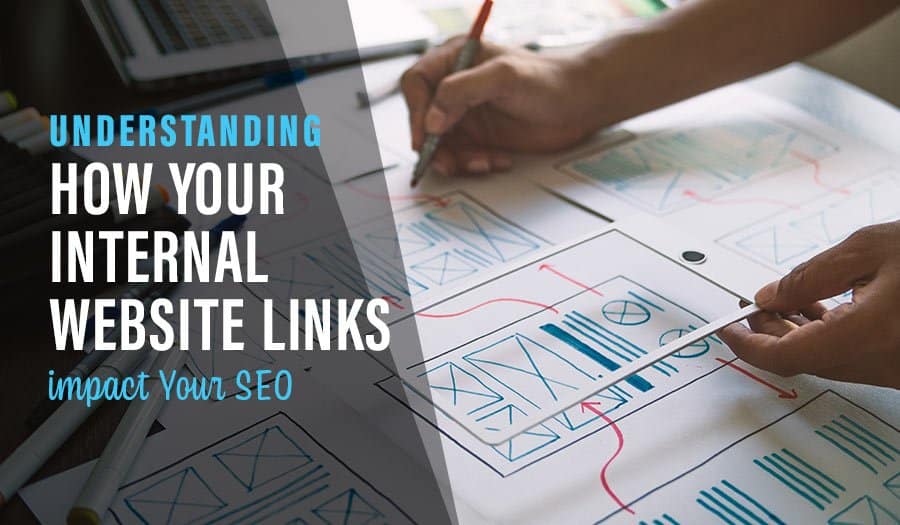Backlinks are a common topic in the SEO world, but internal links are much less discussed. This leads some to believe that internal links aren’t important to SEO. In reality, nothing could be further from the truth. Internal links play a big role in how search crawlers view your page. They provide it with key contextual information it needs to crawl the page correctly and determine your page’s ranking. In this post, we’ll examine exactly how website internal links help your SEO. Let’s explore how your Internal Website Links impact SEO on your website.
What are internal links?
An internal link is a link on one of the pages of your website that links visitors to another page on your website. These differ from external links, which are links on your web pages that link a user to another third-party website. Internal links also differ from backlinks, which are links on another website that link users to a webpage on your site. Internal links are the primary navigation tool on your website.
Types of Internal link
Before we go any further, let’s talk first about the different types of internal links. This is important information because the type of internal link also plays a role in how a search engine views the page. As we examine the various types of internal links, we’ll also take a look at how a search crawler will interpret that type of link and why it behaves that way.
1. Body links
These are also called content links. They are the links inside the main body of your HTML file. For example, if you have a blog post that links to another blog post to further explain a topic, that would be a body link. Search engines love these types of links. Because they are unique to the page they are on, they can tell the search engine something about the content of the page, and that it relates to the page being linked to.
2. Breadcrumbs
Not every website has or needs to have breadcrumbs. These are a type of navigational link, but they remain relatively specific to a given page. They are designed to make it easy for a user to navigate a hierarchy. A common example of breadcrumb links is the category links at the top of e-commerce listed. Users can quickly click on the breadcrumbs to move up a category or even all the way back to the root category. While they make for a great user experience, they also tell search engines a little about the page and quite a bit about how it relates to other pages on the site.
3. Navigation links
These are the primary ways a user moves around your site. They are typically at the top of the page or in a sidebar. While they may change a little as customers move from section to section of the site, they tend to be more static than breadcrumbs and are certainly more static than body links. For that reason, they tell the search engine very little about what’s on the page. However, they serve an important role; they provide links for the web crawler to ensure it hits every page it’s supposed to and tell it about the site’s main pages.
4. Footer links
Links in the page’s footer only link to a website’s most important pillar pages. They are designed to help users quickly navigate to the site’s important pages. Since they are often even more static than navigation links, they provide almost no context at all about what page is about. But, like navigation links, they are useful to search engines in the same way they are to humans; they provide a map of the important pages of a site.
How internal links help your SEO
Now that you have a general idea of how search engines view internal links and the types of information it can glean from them, let’s take a close look at exactly how that information is used and the benefit it provides to search engine optimisation. Below are the key elements that a search engine uses for ranking pages about which internal links can provide information.
1. Visibility
This is the most important thing internal links can do for your website, both for humans and for search engines. A page with no internal links is accessible only to those who know the URL. Nobody else can find it, including search engines. These so-called orphaned pages can provide none of the benefits that we’ll discuss below.
2. Structure
We’ve already discussed a bit about how search engines use internal links to determine how your pages relate to one another. Once the search engine’s crawler has viewed all of your pages, it can use these links as your site map. It will begin to understand the hierarchy of your website, which pages relate to each other, how they relate, what information they have in common, and where they differ. These all provide valuable tools to the search engine as it attempts to find if any pages of your site are relevant to a user’s search.
3. Context
Keywords are important, but they don’t tell the whole story. Imagine you have a page about tyres. On this page, you describe in deep detail what the different types of tyres are and how they’re made. To the right person, this would be a fantastic resource. But for someone searching for places to buy tyres, it’s all but useless. While there will certainly be context clues on the page itself that help the search engine determine this, internal links provide additional context that increases the accuracy.
4. Trust
Search engines are big on trustworthiness or authority. They want to know that they’re sending their users to a page that will provide accurate and meaningful information. You can’t directly gain trust from internal links. That is built from things such as the number of backlinks and other factors. However, when pages on your site that have a high trustworthiness score link to another page on your site, a little of that trust ranking gets carried over.
5. Bounce rate
A key indicator of how beneficial your site is to the search engine’s users is its bounce rate. Bounce rate refers to the percentage of users that leave your page without going beyond the first page they visit. Internal links in blog posts and other website content areas encourage users to explore further. As they move through the site, your bounce rate will decrease, and the search engine will view that page as more valuable to its users.
6. Traffic
This is a continuation of the last one. A page that gets more views is also considered to be more valuable by search engines. Internal links send users to other pages on the stile, increasing the traffic to those pages. When many people visit a page, search engines will assume that many more will want to and push it higher in the rankings.
7. Content Ranking
While having high traffic tells the search engine which pages users find interesting, this doesn’t paint the whole picture. When a page has a lot of internal links pointing to it, the search engine knows that you think the page is important. Assuming the pages doing the linking have a high enough trust rating, the search engine will use this information to prioritise which of your pages are pushed higher in the ranks.
Making the most of internal links
To further examine how search engines use the information discussed thus far, let’s take a look at a few simple tips to maximise the effectiveness of internal links using what we’ve learned.
1. Create a logical hierarchy
We’ve seen more than a few examples of how search engines use the structure of your website to determine the relevance of a given page to a user’s query. When a website is haphazardly thrown together, with little rhyme or reason to its structure, the search engine’s job becomes much harder. If it can’t figure out how your pages relate to one another, the ranking of all of them will suffer.
2. Share the authority
Some of your pages will naturally have a higher trustworthiness score than others. These high authority sites are perfect places to put internal links. By linking from a high trust page to other relevant pages, you’ll be spreading a little of that trustworthiness around and improving the chances of the linked page getting higher in the rankings.
3. Choose the anchor text carefully
Like human visitors, search engine crawlers use the anchor text of a link to figure out what is on the other side of the link. Generic text such as ‘read more or ‘click here’ may tell a human quite a bit about what’s on the other side, provided there are enough context clues. Search engines are quite that smart, though. Rather than make them rely on context clues, use more descriptive anchor text that spells out what is being linked to.
Let us help with your SEO
Now that you know how your Internal Website Links impact SEO, you can see that proper SEO is one of the most important things you can do to grow your business. The more organic traffic you bring in, the less you need to rely on paid ads. However, getting SEO right requires both a lot of knowledge and a fair amount of labour. Contact us today if you need help making sure your site is helping search engines as much as possible. We’ll be glad to help optimise your existing site or design you a brand new, SEO-friendly site from scratch. Search Engine Optimisation
Take your business to the next level with a Pixel Fish Website.
Check out some of our latest Website Design projects.
Further Information
Pixel Fish Hosting, Support & Maintenance
Is your WordPress Hacked? Here are 5 Potential Reasons
Read More
How to Create the Perfect LinkedIn Profile
6 Key Benefits of a 90-Day Business Plan
Top 5 Common Start-Up Mistakes to Avoid
3 Numbers Every Business Owner Should Know
The Top 10 Mistakes to Avoid When Creating a Business Website
The Top ECommerce Web Design Trends you need to know
6 Signs You Should Walk Away from a Prospective Sale
Where to Find Your Next Big Ecommerce Product Idea
How Quality Website Design Stops your Business looking Cheap
Web Design Time Travel: A Brief History of Websites
5 highly Effective Small Business Web Design Tips for Success
The History of WordPress Web Design: Where it all began
4 Ways to Increase Website Emotional Engagement
Landing Page Design: Understanding the various Types of Landing Pages
Better E-Commerce Website Tips: 4 of The Best
10 Tips that Maximise Your WordPress Website Design ROI
Top Reasons Why Your Website Speed Impacts Your Business
4 Essentials of E-Commerce Website Design that Converts
Flying High: How to Promote your website after launch
How to Create a Landing Page for Your Small Business



